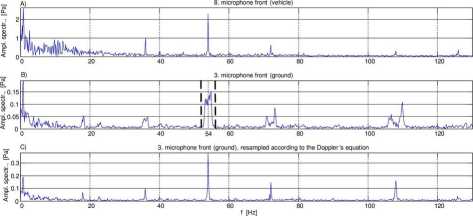6837092911
Diagnostyka’ 4(48)/2008 7
DYBAŁA, GALĘZIA, MĄC7.AK, Yerification Of Doppler Effect RemovalMethodFor The Needs Of...

Fig. 5. Time wavefonns with selected parts for removing Doppler Effect

Fig. 6. Acoustic pressure amplitudę spectrum for reference signal recorded A) near the front bearing of the vehicle; B) on the front microphone of a ground pass-by station; C) Signal froin B) with Dopplers Effect removed using eąuations (1) and (2)
To apply this method a part of a recorded signal should be selected symmetrically to the microphone position. Any errors would result in additional freąuency smear of the resampled signal. On the Fig. 5 the recorded time signals with selected parts corresponding to the front and rear inicrophones of the ground pass-by station as well as a bearing noise reference signal were shown. On the Fig. 6 the results of this procedurę applied to the noise recordings of the vehicle moving with a velocity of 24 km/h were shown. The similarity of signal's spectra recorded with a microphone near the vehicle bearing and spectra of the front microphone on a ground pass-by station is clearly visible. Similar results were obtained for the rear ground pass-by station microphone signal. The differences in the amplitudes of the signals are due to the distance between the inicrophones of the ground station and the railway track (4 m).
The described method lias one serious drawback. It reąuires the precise knowledge of tlie vehicle position relative to the stationaiy, ground microphone as well as its velocity relative to the recording microphone. This method could be inodified to get rid of this flaw.
Wyszukiwarka
Podobne podstrony:
Diagnostyka’ 4(48)/2008 DYBAŁA, GAŁĘZIĄ, MĄCZAK, Verification Of Doppler EffectRemovalMethodFor The
Diagnostyka’ 4(48)/2008 DYBAŁA, GALĘZIA, MĄCZAK, I erificalion Of Doppler Effect Removal AleihodFor
Diagnostyka’ 4(48)/2008 DYBA!A, GALĘZIA, MĄCZAK, 1 erification Of Doppler Effect ReniovalMełhodFor T
Diagnostyka’ 4(48)/2008 11 KEKEZ, AMBROZIK, RADZISZEWSKI, Modeling of Cylinder Pre
Diagnostyka’ 4(48)/2008 13 KEKEZ, AMBROZIK, RADZISZEWSKI, Modeling of Cylinder Pre
Diagnostyka’ 4(48)/2008 15 KEKEZ, AMBROZIK, RADZISZEWSKI, Modeling of Cylinder Pre
Diagnostyka’ 4(48)/2008 Jubileusz prof. Lesława BĘDKOWSKIEGO / Jubilee of Profesor Lesław
Diagnostyka’ 4(48)/2008 KEKEZ, AMBROZIK, RADZISZEWSKI, Modeling of Cylinder Pres surę in Compression
10 Diagnostyka’ 4(48)/2008 KEKEZ, AMBROZIK, RADZISZEWSKI, Modeling of Cylinder Pre
12 Diagnostyka’ 4(48)/2008 KEKEZ, AMBROZIK, RADZISZEWSKI, Modeling of Cylinder Pre
14 Diagnostyka’ 4(48)/2008 KEKEZ, AMBROZIK, RADZISZEWSKI, Modeling of Cylinder Pre
16 Diagnostyka’ 4(48)/2008 KEKEZ, AMBROZIK, RADZISZEWSKI. Modeling of Cylinder Pre
17 Diagnostyka 4(48)/2008 BARSZCZ, MASKA, Application of Hardware-In-Loop for 11irtualPower
Diagnostyka’ 4(48)/2008 BARSZCZ, MAŃKA, Application ofHardware-In-Loop for 1 irlual Power Piani •
Diagnostyka 4(48)/2008 Spis treści / Contents Jubileuszprof. Lesława BĘDKOWSKIEGO / Jubilee of Profe
Diagnostyka 4(48)/2008 Spis treści/ Contents Jędrzej MĄCZAK - Politechnika
Diagnostyka’ l(45)/2008 13 RYBCZYŃSKI, Maps ofTolerable Misalignments of Bearings
Diagnostyka’ l(45)/2008 15 RYBCZYŃSKI, Maps ofTolerable Misalignmenls of Bearings
Diagnostyka’ l(45)/2008 17 RYBCZYŃSKI, Maps ofTolerable Misalignmenls of Bearings
więcej podobnych podstron